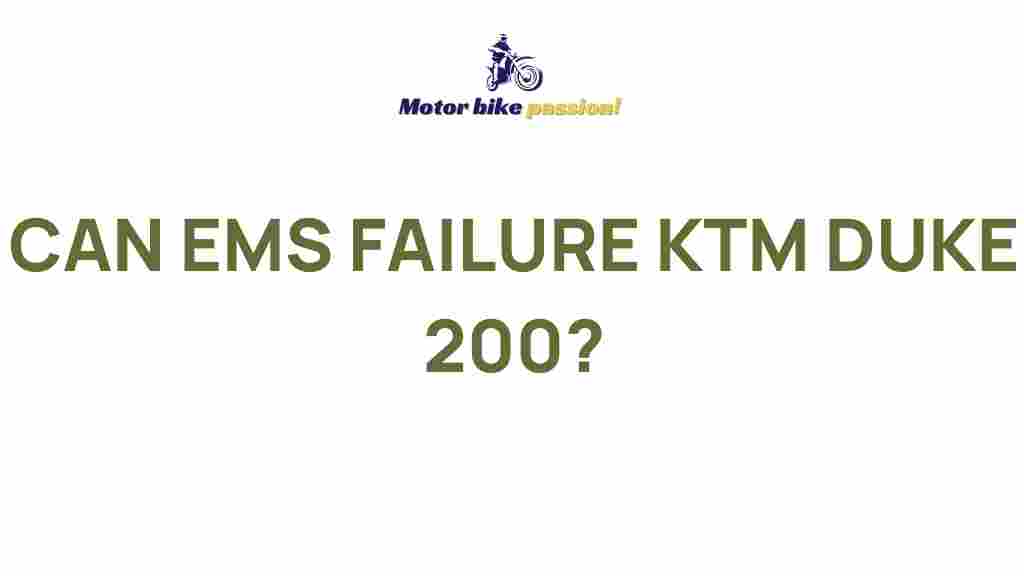Unveiling the Mysteries of EMS Failure in KTM Duke 200
The KTM Duke 200 is a popular choice among motorcycle enthusiasts due to its sporty design and powerful performance. However, like any machine, it is not immune to issues, particularly concerning its electrical system and engine management system (EMS). One common problem faced by riders is EMS failure. Understanding the causes and solutions to this issue is crucial for maintaining the performance and reliability of your KTM Duke 200. In this article, we will delve into the intricacies of EMS failure, offering step-by-step troubleshooting tips to help you get back on the road.
Understanding EMS Failure
The Engine Management System (EMS) is a critical component of the KTM Duke 200’s electrical system. It controls various engine functions such as fuel injection, ignition timing, and emission controls. When the EMS fails, it can lead to a range of performance issues, including poor acceleration, rough idling, and even complete engine failure. Recognizing the symptoms and identifying the root causes of EMS failure is essential for effective motorcycle troubleshooting.
Common Symptoms of EMS Failure
Before diving into the troubleshooting process, it’s important to recognize the signs of EMS failure in your KTM Duke 200. Here are some common symptoms:
- Check Engine Light: The most obvious sign is the illumination of the check engine light on your dashboard.
- Stalling: Frequent stalling or difficulty starting the engine can indicate issues with the EMS.
- Reduced Power: You may experience a noticeable drop in power and acceleration.
- Erratic Idle: The engine may idle roughly or fluctuate in RPMs.
- Increased Fuel Consumption: A failing EMS can lead to poor fuel efficiency.
Step-by-Step Troubleshooting Process
If you suspect that your KTM Duke 200 is experiencing EMS failure, follow these steps for effective motorcycle troubleshooting:
1. Check for Error Codes
The first step in diagnosing EMS failure is to check for any error codes stored in the ECU (Engine Control Unit). Use an OBD-II scanner or a specialized KTM diagnostic tool to retrieve the codes. Here’s how:
- Connect the scanner to the diagnostic port.
- Turn on the ignition without starting the engine.
- Follow the scanner’s instructions to read the error codes.
Note down any codes related to the EMS to help pinpoint the issue.
2. Inspect the Wiring and Connectors
A common cause of EMS failure is damaged wiring or loose connectors. Inspect the following:
- Wiring Harness: Look for frayed or exposed wires.
- Connector Pins: Ensure that the pins in the connectors are not corroded or bent.
- Ground Connections: Check for secure ground connections, as poor grounding can lead to electrical issues.
3. Test the Sensors
The EMS relies on various sensors to function correctly. Common sensors to check include:
- Throttle Position Sensor (TPS): Ensure it is calibrated and functioning.
- Mass Air Flow Sensor (MAF): Clean or replace if necessary.
- Oxygen Sensors: Faulty O2 sensors can cause incorrect air-fuel mixture readings.
Use a multimeter to test the sensors for proper voltage and resistance.
4. Examine the Fuel System
Sometimes, EMS failure can be linked to issues within the fuel system. Check the following components:
- Fuel Pump: Ensure the pump is functioning and delivering the correct pressure.
- Fuel Filter: A clogged fuel filter can restrict flow and affect performance.
- Fuel Injectors: Clean or replace dirty or malfunctioning injectors.
5. Inspect the Battery and Charging System
A weak or failing battery can lead to EMS issues. Follow these steps:
- Check the battery voltage with a multimeter; it should read around 12.6 volts when fully charged.
- Inspect the charging system, including the stator and rectifier, for proper operation.
6. Reflash or Replace the ECU
If all else fails, the issue may lie within the ECU itself. In some cases, reflashing the ECU can resolve software-related problems. If the ECU is physically damaged, replacement may be necessary.
Additional Motorcycle Troubleshooting Tips
In addition to the steps mentioned above, here are some general motorcycle troubleshooting tips that can help you maintain your KTM Duke 200:
- Regular Maintenance: Keep up with routine maintenance, including oil changes, filter replacements, and chain adjustments.
- Use Quality Parts: When replacing components, always use high-quality or OEM parts to ensure reliability.
- Stay Informed: Join KTM forums or groups to share experiences and learn from other riders.
For more detailed information on motorcycle maintenance, you can check out this comprehensive guide.
Conclusion
EMS failure in the KTM Duke 200 can be a frustrating issue for motorcycle owners, but understanding the symptoms and troubleshooting steps can help you diagnose and resolve the problem effectively. By regularly inspecting the electrical system, sensors, and fuel system, you can prevent EMS failure and ensure the longevity of your motorcycle. Remember to stay proactive with maintenance, and don’t hesitate to consult a professional if you encounter persistent issues.
For more insights into motorcycle troubleshooting, tips, and tricks, explore our resources to keep your ride in top shape.
This article is in the category Maintenance Tips and created by MotorBikePassion Team
